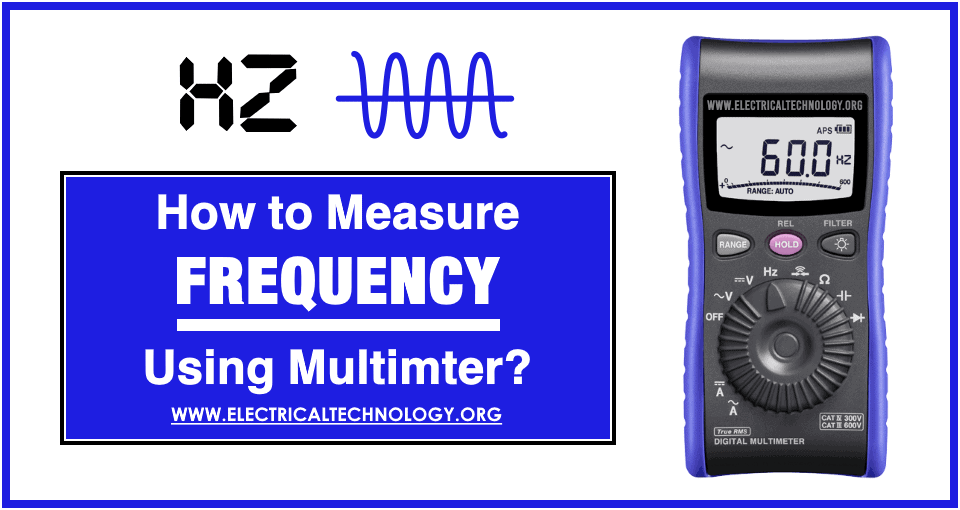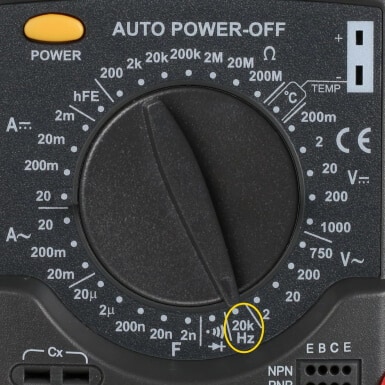How to Read Frequency With a Multimeter
Measurement of Frequency with a Digital Multimeter
Frequency is the number of cycles completed in one second of time. There are unlike kinds of multimeters that tin measure out frequency. Alternating current and other electrical signals possess frequency that affects the operation of a device. By using a multimeter, we tin measure multiple quantities such every bit voltage, current, resistance, capacitance, frequency temperature and continuity, etc and testing electrical and electronic components such as resistors, capacitors, diodes, transistors and cables & wires etc.
In this article, nosotros are going to study how a multimeter measures frequency and what are the factors that affect its reading.

Working Principle
A digital multimeter that can measure frequency has a peak-detection excursion. The meter measures the time betwixt the two sequent crests (pinnacle of waveform) using the peak-detection circuit. it detects the superlative of the input waveform and starts the timer. When the next acme of the waveform is detected, it stops the timer. The meter calculates the frequency using the time between the two crests of the waveform.
Related Posts:
- How to Measure Current using Digital and Analog Multimeter?
- How to Measure Voltage using Digital and Analog Multimeter?
Measuring Frequency
Whatsoever digital multimeter that can measure frequency has "Hz" written anywhere on the punch and upon the ports where probes are inserted. It may also share a spot on the dial with "VAC" or "V~".
At that place are two methods for measuring frequency on a multimeter. If your multimeter has a defended spot on the dial, then follow this method.
Method 1
- Plough the meter ON by switching the ON/OFF push.
- Turn the dial to "Hz", information technology shares a spot on the dial with any other function such equally "VAC or V~". Pressing the "shift" push button access the secondary option and starts measuring frequency. "Hz" appears on the display to ostend the meter has switched to frequency measurement.

- Some multimeters have a defended spot for frequency measurement on the dial that has "Hz" written on it.
- Insert the black probe first into the "COM" port.
- Then insert the red probe into the port having "Hz" written on it.

- Connect the blackness lead get-go and then the cherry-red pb to the betoken of measurement.
- Annotation the reading from the display.
- If your multimeter has different ranges, reduce the range to get an accurate reading. Near multimeters have "car range" push button to select the proper range based on the reading.
- When finished, remove the red atomic number 82 kickoff and and then the black pb.
- Remove the blackness and ruby-red lead from the meters ports.
- Turn off the meter or plough the dial to "voltage measurement" to avert any potential harm in case of quick reuse.
Related Posts:
- How to Measure Resistance using Digital & Analog Multimeter?
- How to Check a Capacitor with Digital (Multimeter) and Analog (AVO Meter)
Method 2:
Some multimeters accept a divide push for "Hz". For such meters, follow the following procedure.
- Plow the meter ON by switching the ON/OFF button.
- Plow the dial to "VAC or Five~".
- Select the maximum voltage range, if the multimeter does non have an automobile-range feature.

- Insert the black probe offset into the "COM" port.
- Then insert the red probe into the port having "V Ω" or "Hz" written upon it.
- Connect the black lead first and then the red lead to the point of measurement. Swapping the leads does non affect the reading.
- Press the "Hz" button to switch to frequency measurement.
- Note the reading from the brandish.
- If possible reduce the range to go an accurate reading. Auto-range feature selects proper range based on the reading.
- When finished, remove the scarlet lead start and then the black pb.
- Remove the black and cherry-red pb from the meters ports.
- Plow off the meter or turn the dial to "voltage measurement" to avoid whatever potential impairment in case of quick reuse.
Related Posts:
- How to Perform the Continuity Test with Multimeter?
- How to Test a Relay? Checking SSR and Gyre Relays?
Problems Incurred during Frequency Measurement
There are many issues that tin can affect the frequency reading of a multimeter. We can reduce some of them to become an authentic reading.
Range of the Meter
The datasheet of a multimeter shows the everyman and highest frequency the meter tin can accurately measure. If the input frequency falls below the range, the multimeter may brandish a reading close to the actual reading but not accurate enough. The same thing volition happen to a higher frequency to a higher place the range. The meters may not keep upwards with the actual frequency and brandish lower readings or show "OL" overload.
Therefore, it is necessary to know the range of the meter and the estimate frequency of the input signal.
Baloney in Input Signal
If the input signal has frequency distortion, it can affect the reading of the multimeter and cause dubiousness in the reading. The reading may also fluctuate. The indicate can be filtered from noise by using a low pass filter.
Related Posts:
- How to test a battery with Test meter?
- How to Exam and Set the Printed Circuit Board (PCB) Defects?
Indicate Radiation
Sometimes, the multimeter may pick up the frequency reading without probes touching the line. it may occur due to the unshielded lines that human activity equally antennas to radiate the EMI (Electromagnetic interference). The meter picks up the signal, amplify and measure out It and display the reading. It may or may not be accurate. Therefore, information technology is best to physically connect the probes to the wire.
Why do Nosotros Measure Frequency?
Measuring frequency is important because circuits and machines are designed to operate at specific frequencies. They either operate at fixed frequency or variable frequency where the output depends on information technology.
One such instance is an AC electric motor whose speed is straight proportional to the frequency of the mains supply. A motor or transformer designed to operate at 50 Hz volition run at a college speed if continued to a 60 Hz supply. Similarly, a 60 Hz motor and transformer volition be slower if information technology runs on a 50Hz supply. Hither is an interesting question for you :) Is it Possible to Operate a 50Hz Transformer on 5Hz or 500Hz Frequency?.
Skilful to Know: Frequency can't be measured using an Analog Multimeter. Only defended digital multimeters with specific features (like defended Machine Hz push button or split Com concluding) can be used to measure frequency in unlike ranges even upwardly to 100kHz or more.
Related Posts:
- How to Test a Diode using Digital and Analog Multimeter
- How to Check a Transistor by Multimeter (DMM+AVO)
- How to Exam Electrical and Electronics Components and Devices with Multimeter
- Bones Electrical and Electronics Applied science Tools
- How to Observe The Suitable Size of Cablevision and Wire for Electric Wiring Installation?
- How to Find the Proper Size Outlets, Receptacle and Switch?
- How to Find the Right size of circuit breakers?
- How to Calculate the Value of Resistor for LED's?
- How to Calculate the Battery Charging Time and Charging Current? Case
- How to Find the Proper size of Earth Conductor, Globe Lead and Earth Electrodes?
- Resistor Color Code Calculator – three, 4, v & six Band Resistors Calculation
- How to Detect The value of Burnt Resistor? (4 Methods)
Source: https://www.electricaltechnology.org/2021/07/measure-frequency-using-multimeter.html
0 Response to "How to Read Frequency With a Multimeter"
Post a Comment